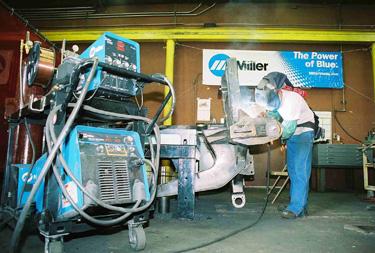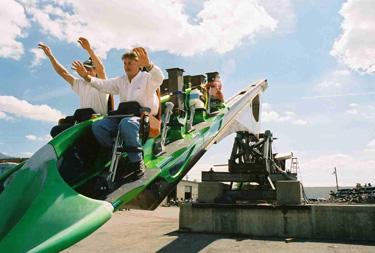The Metal Shop's Quality Welds Let Thrill Seekers Go Over the Edge...and Come Back Again
As you're hurtling headlong at 30 miles per hour over the edge of a hotel's observation deck some 870 feet in the air, you may question your sanity. However, it's definitely not the time to start questioning the quality of the amusement ride's welds.
The fabricator responsible for bringing the thrill seekers back alive is The Metal Shop of Logan, Utah, a small but highly experienced shop that was picked to build a world-class amusement ride because of its reputation for quality and productivity.
At a height of over 870 feet, the Stratosphere tower in Las Vegas is a perfect spot for adrenaline junkies to get an eye-popping view of the strip.
Owners Kirk Hunt and Kevin Jepperson, along with five other operators, know all too well that their reputations "ride" on their ability to turn out quality welds every time. That's why they depend on XMT 304 and XMT 456 CC/CV inverter power sources from Miller Electric Mfg. Co. Another key to their productivity and quality is using Miller's 70 Series dual wire feeders.
X Scream Challenge
Since starting The Metal Shop in 1999, Hunt and Jepperson have completed numerous amusement ride projects. But their biggest challenge came when Interactive Rides asked The Metal Shop to fabricate a new ride for the Stratosphere Hotel and Casino in Las Vegas. The ride was called, appropriately enough, X Scream.
 |
|
Precision welding within the metal shop.
|
"We've known the guys who started Interactive Rides for a number of years and we have done a lot of their work," Jepperson says. "When they started their business, they came to us and said they didn't want to get into the fabricating and asked if we would do the fabricating for them because of our experience and quality work. That's how it started."
Hunt points out the X Scream project "is definitely our biggest so far. It's been a challenge and it's been a lot of fun. While it's been our biggest project by far, it's also more like what we're trying to get into."
A few words about X Scream. It consists of an open, eight-passenger car without sides—so the rider can see all the way to the street below. The car sits on a 65-foot track, about 31 feet of which extends over the edge of the hotel's observation deck.
Once the passengers are safely tucked in, the ride tilts to a 30-degree angle and the car races at 30 miles per hour over the tower's edge toward the ground below. However, instead of continuing to plummet, the car—thanks to a magnetic brake system—races back and forth over the edge until the ride is over.
Countless Multiple Passes
Behind the scenes, a great deal of meticulous planning and hard work, including several months of welding countless numbers of multiple pass welds, went into taking X Scream from the drawing board to reality.
Kevin Jepperson, co-owner and welding expert at The Metal Shop, believes passionately in the XMT 456/70 Series dual feeder combination. "We weld on a huge variety of metals. Having the XMT paired with a 70 Series dual feeder lets us choose a welding process tailored to match the metal thickness and joint design. Having a dual feeder is an absolute necessity.
 |
|
Testing while still on the ground.
|
"The track for the ride consists of two 65-foot I-beams, one on each side, and that's what the passenger vehicle actually rides on," Hunt says. "Then there's a mix of pipe, square tubing and rectangular tubing for the cross bracing, along with sheet metal skins. There's just a whole menagerie of bracing throughout that entire piece for a combination of strength and weight reduction."
When completed, the track weighed in at 10,000 to 12,000 pounds and it took a couple of forklifts to get it out of the shop—very carefully.
One of the biggest challenges The Metal Shop faced was working with material thicknesses that varied tremendously, Jepperson says. For example, metal thickness varied anywhere between 1/8-in. and 1/4-in.
"In cases such as this, you have to use two different processes, depending on the thicknesses, and that's where the 70 Series dual feeders come into play because you want to go from one to the other without a lot of nonproductive set-up time," Jepperson says. "On some of the thicker plate we had as many as three passes on some of the joints that made up the main structural connections. And some of them required five, six or seven passes of gas-shielded flux cored wire."
Jepperson explains that welding procedures specified a root pass with solid wire (MIG process) and then subsequent passes with flux cored wire. With thicker materials, the edges are beveled and the first pass is MIG-welded with a smaller diameter wire that requires less heat. After the first pass is made at lower heat, then the joint can be flux cored with greater penetration.
XMTs, Dual Wire Feeders
Jepperson likes the fact that the XMT combines the advantages of inverter-based power with the built-in features and productivity of high-end MIG machines. "We also TIG weld stainless and tool steel, as well as MIG weld aluminum with Miller's XR-Edge feeder. And in some cases we have to Stick weld some things. What better power supply for all process welding than an XMT?" he says.
"I wasn't familiar at all with dual feeders until we went to an auction and picked one up. But now, after using it, my question is, 'Why aren't all the other shops using it?'" he says. "In my opinion, any shop that doesn't have a dual feeder running multiple wire types is compromising its quality by limiting what its employees can do with the welding and fabricating."
Jepperson points out, "We are welding on such a wide variation between material thicknesses that with the two different processes we can have one machine tailored to all thicknesses and joint designs."
The welding parameters included 25 volts and 300 inches per minute for the E71T-1 flux cored wire (shielded with 100 percent CO2) and 22 to 26 volts and 400 to 500 inches per minute for the ER70S-6 hard wire (with an 85/15 mixture of Argon/CO2 shielding gas). The E71T-1 flux cored wire was .045-in. diameter and the ER70S-6 hard wire was .035-in. diameter.
No Acceptable Alternatives Based on his experience with dual wire feeders, Jepperson thinks the alternatives are not at all acceptable, particularly on projects such as X Scream that absolutely demand producing high-quality work while meeting tight deadlines.
Operator Ryan Davis uses the 70 Series dual wire feeder to weld the chassis assembly of a roller coaster. "I've worked other places where they're always switching out wire spools. Miller's 70 Series dual feeder saves a lot of time. Also, it's really important to use the right wire type for the job," he says.
|
|
|
The ride as it appears today mounted on top of the Las Vegas Stratosphere.
|
"There are only two other options: Either have a guy who does nothing but hard wire with one machine and have another guy come after him with flux cored, or have the guy weld it with hard wire and then stop to swap out his wire, swap out his tip, swap out his drive rolls and then weld it with flux cored," he says.
Both options adversely affect productivity and quality. In the first scenario, productivity depends on how fast the operator welding hard wire can complete his work. And in the second scenario, downtime builds up—an extra 15 or 20 minutes each time—while the operator stops to make the necessary equipment changes to suit the wire size, according to Jepperson.
And what about the impact on quality?
"Without a dual wire feeder, the quality of the weld joint may be sacrificed because sometimes operators don't want to take the time to swap wires or gas. So, they'll take that machine and where it's set up for flux cored they'll say, 'Oh, it's just that one little joint, let me hurry up and weld it and I'll make it work'," Jepperson says. "Or, same thing with the hard wire: 'Well, if I just preheat it a lot, I'll be okay if I just weld it with that hard wire.' But we know they will be sacrificing quality."
David Phippen, one of The Metal Shop's operators, loves working with a dual wire feeder system. "It's sweet. It's great having both of them (wires) on there," Phippen says. "If we had to worry about switching back and forth between the wires it would just be a mess. It would take three times as long."
Because The Metal Shop spends so much time fabricating amusement rides, ensuring weld quality is a top priority.
"We have a third party who does all the inspections on everything we do," Hunt says. "And he's here throughout the whole process, stopping in and taking photographs and documenting everything."
Marvin Reeder, owner of Reeder Welding Services Quality Management, served as the third-party inspector for the X Scream weldments.
Metal Shop operator David Phippen works on a roller coaster cart. He says, "The 70 Series dual feeder combination is the only way to go. It's way better than dragging two big old machines in and out of an area all the time. That's an extra 15 or 20 minutes every single time you have to change your wire that you could be building something instead."
Operators Fix Welds
"The specifications on this project called for the inspection to conform to AWS D1.1 Section 6, with the primary inspection being visual," Reeder says. "We've done some destructive testing, used liquid penetrant and magnetic particle, but these inspection techniques were to support visual observations."
Based on his experience, Reeder points out welding operators ultimately are responsible for quality. At The Metal Shop, operators often take it upon themselves to fix a weld that's not acceptable. "A lot of times they take corrective measures before I do my inspections. There have been a number of times when the welds have been reworked, profiles have been modified and stop/starts have been ground and blended in before I see it. They've been trained properly and they know what's required, and that makes my job a little easier.
"In all honesty, the quality that has been put into this ride is as good as anywhere in the world," Reeder says. "There is no place where the work is done any better, or this ride probably would have been done elsewhere. That's the bottom line."